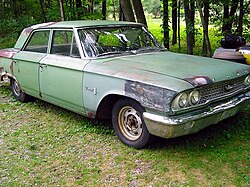Ford 300 (automobile)
| ford | |
|---|---|
| 300 | |
| Production period: | 1963 |
| Class : | upper middle class |
| Body versions : | Limousine , coupe |
| Engines: |
Petrol engines : 3.7–7.0 liters (101–313 kW) |
| Length: | 5309 mm |
| Width: | |
| Height: | |
| Wheelbase : | 3023 mm |
| Empty weight : | 1613-1651 kg |
| Previous model | Galaxy |
| successor | Custom |
The Ford 300 was a passenger car model made by the American car manufacturer Ford . The model was produced exclusively in 1963 and rolled off the production line in Dearborn . In 1964 the 300 was replaced by the Custom series.
General
The Ford 300 was launched as an economy model of the Ford Galaxie and, in contrast to this, had almost no chrome trim and no luxury equipment. The Ford 300s were often ordered by the police or taxi companies because they were US $ 100 cheaper than the most basic galaxy limousines. The cars were recognized by a “Ford 300” sign on the two front fenders behind the wheel arches and “FORD” in small chrome letters on the trunk lid (instead of “GALAXY”). The vehicles were normally only available as 2- or 4-door sedans, but a hatchback coupé was also available on special request.
A special Ford 300 was sold as a two-door sedan by Tasca Motors in Providence, Rhode Island . It had the chrome trim of the Ford Galaxie and the XL models and was available with interesting two-tone paintwork.
A total of 70,152 examples of the Ford 300 were built.
Body designs
The Ford 300 was used as a two- or four-door sedan - limousine and as a two-door hatchback - coupe offered.
Engines and gears
The smallest available engine was a six-cylinder in-line engine with a displacement of 3654 cm³ and a maximum of 103 kW (138 bhp) at 4200 rpm. There was also a V8 engine with 4736 cc and 145 kW (195 bhp) at 4400 rpm, and a big block V8 engine of the FE series, which was called the 427er (this is the displacement, measured in cubic inches) with 6997 cm³ displacement and 317 kW (425 bhp) power at 6000 rpm was available. In connection with a manual transmission, cars equipped in this way were often used in dragster races because they were very light.
literature
Gunnell, John (editor): Standard Catalog of American Cars 1946-1975 , Krause Publications Inc., Iola (2002), ISBN 0-87349-461-X .
